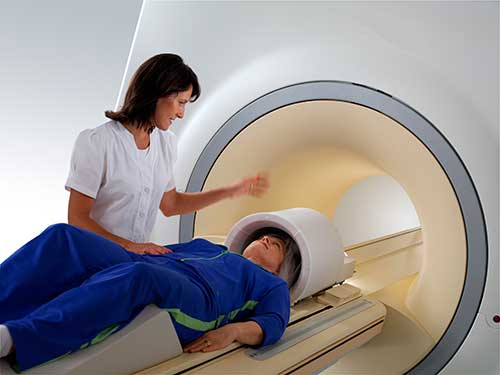Magnetic Resonance Imaging (MRI)
What Is Magnetic Resonance Imaging (MRI) ?
Magnetic Resonance Imaging (MRI) is a sophisticated medical imaging technique that uses strong magnetic fields and radio waves to generate detailed images of the internal structures of the body. Unlike X-rays or CT scans, which use ionizing radiation, MRI relies on the natural properties of atoms to create high-resolution images. MRI is widely used in a variety of medical fields, including neurology, orthopedics, cardiology, and oncology. It plays a crucial role in diagnosing a wide range of conditions and in planning surgical interventions.
- Magnetic Field: When a patient is placed inside the MRI machine, they are exposed to a powerful magnetic field. This magnetic field temporarily realigns the hydrogen atoms in the body.
- Radio Waves: Radio frequency pulses are then applied to the area of the body being imaged. These pulses cause the aligned hydrogen atoms to emit signals that are picked up by specialized detectors.
- Signal Processing: The signals generated by the hydrogen atoms are processed by a computer to create highly detailed images of the internal structures. Different types of tissues in the body produce different signal strengths, allowing for differentiation between tissues.
- 3D Visualization: The reconstructed images can be viewed in various planes (axial, sagittal, and coronal) and can be manipulated to create 3D visualizations, allowing healthcare professionals to examine the body from different perspectives.

What Is The Main Cause Of Magnetic Resonance Imaging (MRI) ?
The main cause of Magnetic Resonance Imaging (MRI) is the interaction between the strong magnetic field and the hydrogen atoms present in the body's tissues. MRI takes advantage of the behavior of hydrogen nuclei, which are abundant in the human body due to the prevalence of water molecules.
- Alignment in Magnetic Field: When a patient is placed inside the MRI machine, the powerful magnetic field causes the hydrogen nuclei (protons) in the body to align with the field.
- Radiofrequency Pulses: Radiofrequency pulses are then applied to the area of the body being imaged. These pulses temporarily disrupt the alignment of the hydrogen nuclei.
- Return to Alignment: After the radiofrequency pulse is turned off, the hydrogen nuclei gradually return to their original aligned state. As they do so, they emit radiofrequency signals.
- Signal Detection: Specialized detectors within the MRI machine pick up these emitted signals.
- Image Reconstruction: The signals detected are processed by a computer to create detailed images of the internal structures. Different types of tissues in the body produce different signal strengths, allowing for differentiation between tissues.
What Is Treatment ?
In the context of Magnetic Resonance Imaging (MRI), "treatment" typically refers to the use of MRI technology for planning and guiding certain medical procedures or interventions. While MRI itself is primarily a diagnostic imaging tool, it plays a crucial role in the pre-operative planning and intra-operative guidance of various treatments. Here are some scenarios where MRI is used in treatment: It's important to note that while MRI is invaluable for planning and guiding treatments, the actual therapeutic procedures are performed separately and often by different medical specialists, such as surgeons, interventional radiologists, or radiation oncologists. The MRI images serve as a crucial tool to enhance the accuracy and safety of these interventions.
Clinical Services
Facilities
24 Hours Services



